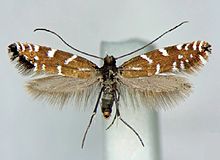
The common pug(Eupithecia vulgata) is a moth of the family Geometridae. It is a common species across the Palearctic region, including the Near East and North Africa. It ranges from the Atlantic coast of Ireland and Portugal across Europe, the Middle East and Central Asia to the Russian Far East (Priamurje) and Korea.

The scalloped oak is a moth of the family Geometridae. The species was first described by Carl Linnaeus in his 1758 10th edition of Systema Naturae.

The dryandra moth is a species of moth that is considered to be the sole member of the family Carthaeidae. Its closest relatives are the Saturniidae and it bears a resemblance to many species of that family, bearing prominent eyespots on all wings. The common name is derived from the Dryandra shrubs of the genus Banksia, on which the larva of this species feed, and is hence restricted to the south-west of Western Australia where these shrubs grow. Other Grevillea shrubs may also be used as host plants.
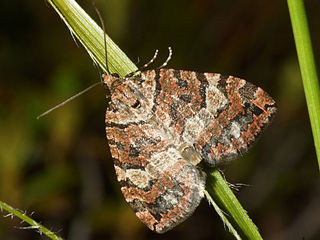
Hydriomena furcata, the July highflyer, is a moth of the family Geometridae. The species was first described by Carl Peter Thunberg in 1784. It is found in the Holarctic ecozone.

Lithophane socia, the pale pinion, is a moth of the family Noctuidae. The species was first described by Johann Siegfried Hufnagel in 1766. It is found throughout western Europe from Spain to central Scandinavia then east across the Palearctic to Siberia, the Russian Far East and Japan.

Mesotype didymata, the twin-spot carpet, is a moth of the family Geometridae. The species was first described by Carl Linnaeus in his 1758 10th edition of Systema Naturae. Its genus is sometimes included in Perizoma.
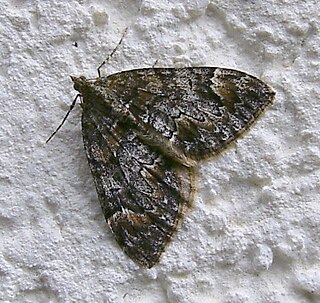
Dysstroma citrata, the dark marbled carpet or northern marbled carpet, is a moth of the family Geometridae. The species was first described by Carl Linnaeus in 1761. It is found across the Holarctic ecozone and has been reported from India.

Callisto is a genus of moths in the family Gracillariidae.

Phyllonorycter quinqueguttella is a moth of the family Gracillariidae. It is found from Fennoscandia to the Pyrenees, Alps, Hungary and Ukraine and from Ireland to central Russia.
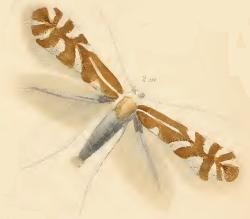
Phyllonorycter salicicolella is a moth of the family Gracillariidae. It is known from all of Europe, east to Russia and Japan.
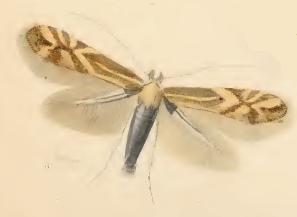
Phyllonorycter salictella is a moth of the family Gracillariidae. It is known from all of Europe, east to Russia and Japan.
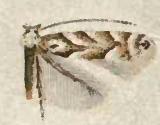
Phyllonorycter salicifoliella is a moth of the family Gracillariidae. It is widespread across North America, from Mississippi to Ontario in the east and from southern California to northern British Columbia in the west.
Phyllonorycter acanthus is a moth of the family Gracillariidae. It is found in scattered riparian habitats in otherwise generally arid, montane regions of the Trans-Mexican Volcanic Belt of Jalisco and Michoacán in Mexico.
Phyllonorycter mildredae is a moth of the family Gracillariidae. It is probably widespread through the eastern United States but currently reported from only Washington D.C., Kentucky and Ohio.

Phyllonorycter scudderella is a moth of the family Gracillariidae. It is widespread in eastern North America from Ontario to Ohio and in western North America from south-eastern Alaska to Oregon.
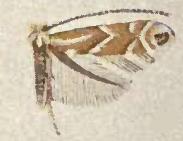
Phyllonorycter apicinigrella is a moth of the family Gracillariidae. It is found along the western coast of the United States from San Luis Obispo County, California, north to British Columbia, Canada.

Callisto coffeella is a moth of the family Gracillariidae found in Europe. It was first described by Johan Wilhelm Zetterstedt in 1839.

Chloroclysta miata, the autumn green carpet, is a moth of the family Geometridae. The species was first described by Carl Linnaeus in his 1758 10th edition of Systema Naturae. It is found from most of Europe to the Alatau in Central Asia.

Chesias rufata, the broom-tip, is a moth of the family Geometridae. It was described by Johan Christian Fabricius in 1775. It has a wide range in central and western Europe, including Great Britain and Ireland. It is also found from Morocco to Asia Minor.The species prefers heaths, bushy slopes and rocky valleys which favour its foodplants. It is found up to 1,500m in the Alps.

Mercantouria is a genus of moths in the family Gracillariidae. It contains only one species, Mercantouria neli, which is known only from a small area of the French Hautes-Alpes and Alpes-Maritimes. The habitat is dominated by subalpine scree and grassland on limestone soil at altitudes ranging from about 1,750 to 2,100 metres above sea level.
